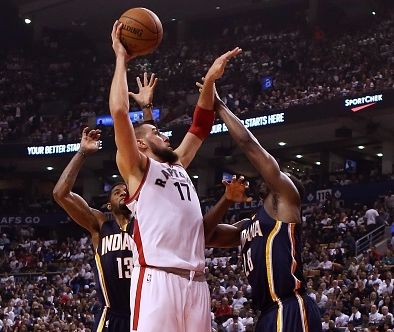It’s hard to be too confident in any declarations made an eighth of the way into the season aside from staining your pants celebrating Steph Curry or trying not shit them because you’re laughing so hard at Byron Scott. Otherwise, we’re just looking at trends and small sample sizes and still trying to guess where it is that they’ll end up. 11 games into the season, let’s look at a few trends and see how the 2015-16 Toronto Raptors squad is shaping up compared to last year’s team.
When it comes to new storylines, there are a couple of big reasons to be happy. Cory Joseph’s contract was widely scoffed at, but if his numbers hold up he’s going to wind up underpaid. Joseph’s biggest supporters might have guessed that his counting stats might be this good (9.5 points, 3.1 assists and 2.6 rebounds in 25 mpg off the bench), but none of them would have predicted the efficiency with which he is doing it. Joseph is shooting 60% from the field on 2pt shots, an astounding number for a point guard, and is averaging 56-40-86 shooting splits! Those are peak Durant and Nowitzki type shooting stats, so you have to expect those to come back to Earth, but even a reasonable reduction still makes Joseph a very efficient guard, which is not a way that Raptors fans are accustomed to hearing their guards or bench units described.
There are storylines from last year that continue to be a problem as well. Jonas Valanciunas is once again one of the most efficient scorers in the league. He’s shooting 58% from the field and ranks in at 6th overall in the NBA in true shooting %. He’s also getting to the line on almost half of his field goal attempts, where he’s shooting 78%. Valanciunas is near the league lead in offensive rebounds and has markedly improved his defensive and overall rebounding. So, why is this seemingly positive trend a problem? Because Valanciunas’ remarkable efficiency has been rewarded with only 1 more attempt per game and 1 more minute played. Casey still seems in favor of pulling Valanciunas defensively at times, which traditionally the numbers supported but this season the Raptors are better on that end with Valanciunas than any other big. The Raptors are -33 in the 4th quarter this year when they play Biyombo instead of Valanciunas. Being an improvement defensively is counter productive when you’re so bad offensively that you make a team with perimeter spacing issues play 4-on-5, and the starters have gotten pummeled late in games without Valanciunas. For a man whose efficiency stats continue to rise with increased work load and reliance, he sure seems to get a very small increase in work load and reliance.
Free throws are key for the Raptors. The Raptors offensive efficiency was far better last season than it felt watching on TV. A big reason for that was the sheer volume of free throws that players like DeRozan, Lowry and Lou Williams were able to unconventionally generate. Shooting free throws is one of the most efficiency-favorable outcomes in basketball, especially for guards. So it was great for the Raptors to be able to do so, and they’ve been able to replicate much of that same success again this year, when they currently lead the league in free throws per field goal attempt. They’re going to have to continue to do so, because they shoot a below average number of 3 point shots and have struggled at times to manufacture easy points. Free throw shooting is buoying their efficiency.
The problem with free throw shooting this season so far for the Raptors has been giving those shots back. The defensive shifts that came with the coaching and player changes through the off season has been mostly welcome. It’s improved the team’s pick and roll defense, allowing far fewer wide open 3s and powered a huge improvement in defensive rebounding, with the Raptors bigs hanging much closer to the basket. The drawback so far has been free throws. The team is giving up free throw shots far more frequently to opposing teams. The Raps take the most free throws, but they also give up the 7th most. It’s not damning, but it takes a serious bite into one of the team’s biggest advantages. The Raptors need to reduce the number of free throws they give up go opponents if they’re serious about making a real improvement.
These are a few of the early trends we’ve seen from the Raptors so far. The team has played a road heavy schedule, but their strength of schedule is going to get harder than it’s been. It wil be interesting to see how the Raptors handle that. The continued play from Joseph, how Valanciunas is used and whether or not the Raptors can consistently improve on explanding their free throw margin will likely play a big role in how that plays out.



